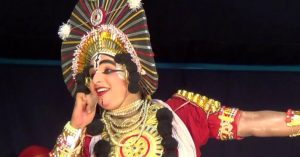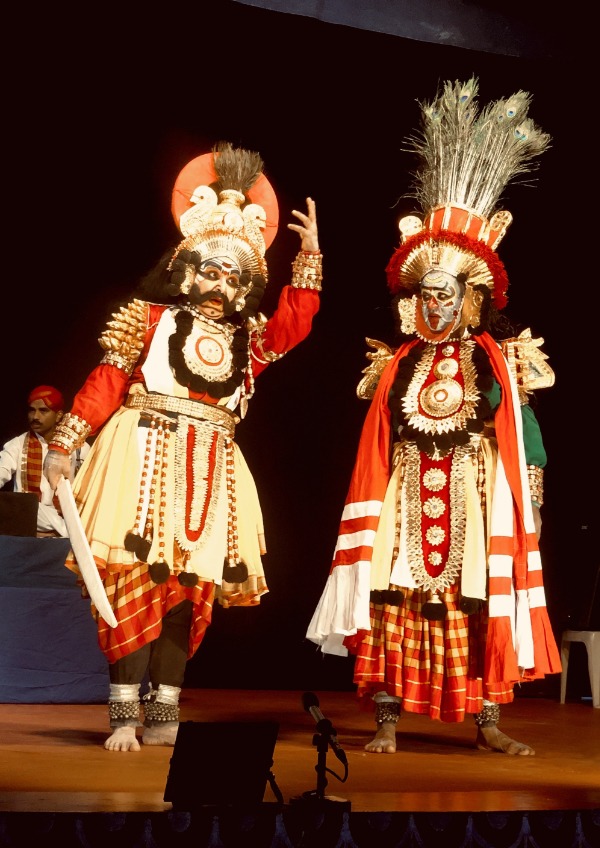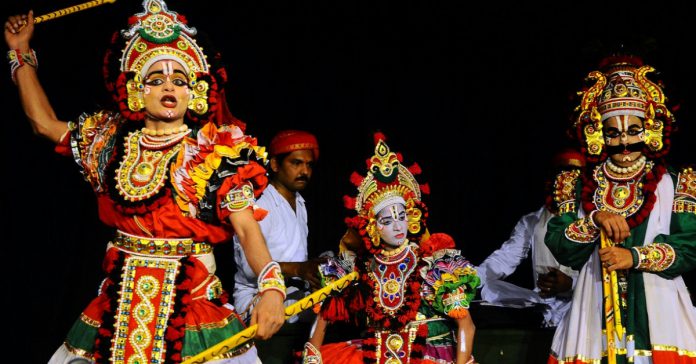Karnataka has a long history of folklore, dances, theaters and all types of art. Yakshagana is one such type of folk theatre from Karnataka having a long history of over 400 years.
Yakshagana
The theatre form includes a unique harmony of eye-catching costumes, musical tradition, and authentic dancing styles. It is well known for improvised gestures, and extemporaneous dialogue which over the years has successfully managed to appeal to an entire generation and community.
Dusk to dawn
Yakshagana is traditionally presented from dusk to dawn. Its stories are drawn from Ramayana, Mahabharata, Bhagavata and other Hindu epics. Yakshagana evolved as a dance form during the Bhakti Movement.
Narahari Tirtha, a disciple of Madhvacharya, is said to be the first person to introduce Yakshagana in Udupi. He was also the founder of Kuchipudi. An inscription dating around 1556 CE has been evidence that Yakshagana existed for a long time.
This inscription has been the first written evidence to cite about this dance form. The inscription was found at the Lakshminarayana Temple in Kurugodu, Bellary.
Origin of Yakshagana
Another evidence was found at Ajapura, present-day Brahmavara. The manuscript is said to have mentioned Yakshagana in the form of a poem that was authored by Ajapura Vishnu.
Researches and Experts have placed the origin of the Yakshagana approximately in the period of 11th and 16th Century CE. Yakshagana became an established art form during the time of Parthi Subba, who was a Yakshagana poet.

Details of Yakshagana
Now, depending on the region, Yakshagana of different variations can be found across Karnataka:
- Moodalopaya: Hasana, Mandya, Tumkur, Chitradurga
- Paduvlopaya: Kasaragod, DK, Udupi, Uttara Kannada
- Tenkutittu: Sampaje, Sulliya, Puttur, Bantwala, Belthangadi, Karkala
- Badagutittu: Kundapura
- Badabadagatittu: North Karnataka
Generally, the stage is built on a mud-based foundation in open ground and decorated with special lighting – similar to theaters. The performance starts in the night and continues until dawn.
The costumes are rich in color where the costumes (or vesha) depend on the characters depicted in the play (prasanga). It also depends on the Yakshagana style (tittu).

Traditionally, Badagutittu, the Yakshagana ornaments are made out of light wood, mirror, and colored stones. The costumes consist of headgear (Kirita or Pagade), Kavacha that decorates the chest, Buja Keerthi (armlets) that decorate the shoulders, and belts (Dabu) – all made up of light wood and covered with gold foil.
Mirror work on these ornaments helps to reflect light during shows and add more color to the costumes. Armaments are worn on a vest and cover the upper half of the body.
The presentation of the puppetry is highly stylized where the puppets (generally 18 inches high) wear costumes similar to those worn by live actors of Yakshagana. They have elaborate makeup, colorful headgear and heavy jewelry. They are known as uthradhari, and contents drawn from ancient epics.
Conclusion of Yakshagana
An offshoot of the “Gurukula scheme” of the Union Government and offers a two-year course in Yakshagana. In the first year, the students are taught the basics such as costumes, dialogues, dance, make-up and episodes from the Ramayana, the Mahabharata and the Bhagavatha. In the second year, students take up specialisation in subjects of their choice. Yakshagana experts design the curriculum.
So, the next time you hear about a Yakshagana performance in your neighbourhood. Go ahead and support this famous Karnataka Heritage.



